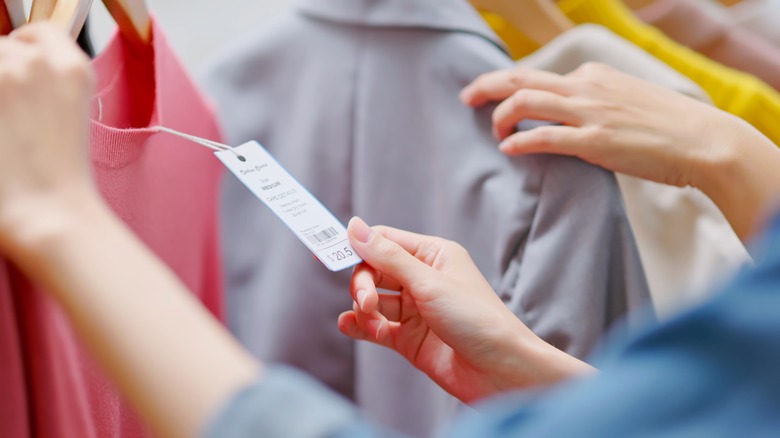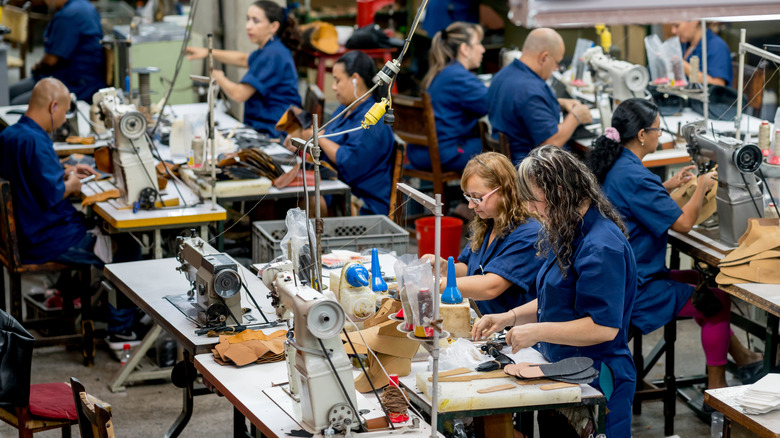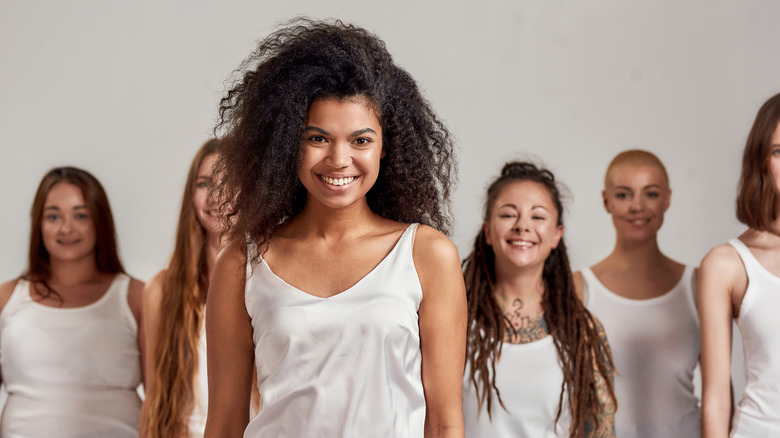Why You Need To Stop Worrying About The Size On A Clothing Tag
You've heard of "vanity sizing," but the term never hit home until the dress you saw online and ordered in your usual size finally arrived only for it to not fit. Your usual brands must tag their clothes with smaller sizes than the actual cut, indicating vanity sizing. And now you feel stung, thinking that you somehow made a mistake — or did you?
The opposite of vanity sizing is not necessarily accurate sizing. The desire for universal sizing charts coincided with the flowering of ready-to-wear manufacturing. Starting in the 1800s with men's military uniforms, a non-tailored clothing trend gradually extended into domestic and women's wear, finding its wings during the industrial revolution. After World War I, the U.S. Department of Agriculture studied women's measurements and decided only five dimensions — weight, height, chest, waist, and hip — were needed to construct a garment. The resulting size chart formed the basis of U.S. clothing patterns until 1958 when new sizes were proposed by the National Bureau of Standards.
As the years passed, average women's clothing sizes adjusted to changing bodies, and standards were revised once again. Meanwhile, individual brands developed a more nuanced understanding of their customers and the right "fit." Soon enough, we landed where we are today: Different brands approaching size in dissimilar ways, so that no universal standard exists to dictate what makes a size 10 a size 10. Bottom line: Don't ever presume a clothing tag has you pegged.
The right fit
Some people believe vanity sizing is the fashion industry's manipulative attempt to appeal to customers. That's simplistic, Kathleen Fasanella, an apparel industry pattern maker, tells Vox. "Everybody sizes to their market, to their customer base." Brands don't fabricate clothes based purely on government statistics. Designers gather additional information about their intended customers and then construct each garment — establish its shape, its spaciousness or snugness, and its tailoring — based on client preferences. Size equals "fit," and fit is the reason many of us prefer one brand or another that feels "just right" on our bodies.
Fabric use is another determinant of both the sizing and pricing of clothes, Fasanella says. With larger sizes using more fabric, and smaller sizes less, the cost per unit is based on size medium. "A medium is not a standard or a set of unchanging dimensions," she writes on her website, Fashion-Incubator. "A medium is the midpoint of the range of sizes a manufacturer produces." This means medium must be the most popular size, notes Fasanella. "If a manufacturer is selling more larges than mediums, it means their medium is too small. The large becomes the medium and the other sizes are adjusted accordingly." To remain in business, clothing companies evaluate and evolve their garment sizes to keep up with clientele demand.
Sizes, then, not only differ across brands but may be inconsistent within brands. No wonder finding your size can seem impossible even with clothing rental subscriptions and other newer ways of finding your perfect 'fits!
Image, size, and body satisfaction
Collectively, we spend a good deal of money and time on our clothes, so it's natural to think quite a bit about our T-shirts, jeans, blouses, skirts, dresses, and pants — and their various sizes. "It's stressful for us if we don't feel comfortable in what we're wearing. Clothes are the closest thing to our bodies, they're our second skin," Carolyn Mair, who created the psychology of fashion department at the University of the Arts London, told the American Psychological Association.
Sizes, then, impact us. And it's not just a matter of our own size, it's also an implicit component of the fashion photography we see. Images (and so the sizes of the models within them) influence us, Mair suggests. "There's quite a lot of research now which shows that even a very brief look at fashion imagery of thin models or airbrushed models can damage a person's body satisfaction, so they feel worse about their body than they did before."
No one needs to feel bad about themselves based on photographs altered to suggest smaller sizes. More representation in the images we see — and a greater range of sizes, too — would translate to less body dissatisfaction, explains Mair: "This isn't just about skin tone, it's about body type, body shape, ages, ability and just the whole range." Maybe it's time you free yourself from taking clothing too seriously and turn to size-inclusive fashion brands that are both reputable and help folks feel their best.


